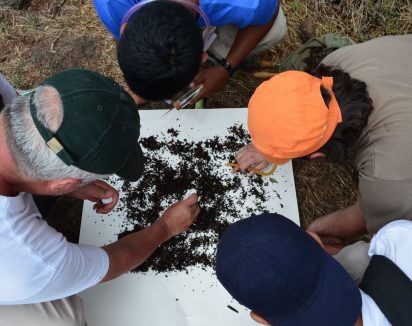
Training in ant taxonomy and ecology at Loja, Southern Ecuador (2011) and in the Galápagos Archipelago with focus on endemic ant species (2012)
Project details
2011 and 2012
Ecuador
Arthropods - Insects: Animalia – Arthropoda – Insecta – Hymenoptera – Formicidae
Royal Belgian Institute of Natural Sciences
2011 project:
Ecuador is one of the most megadiverse countries of the world. Nevertheless, diversity of many taxa, including ants, remains poorly known. Recent surveys and investigations of T. Delsinne in the Andes and W. Dekoninck in the Galápagos Islands indicated that Ecuadorian ant fauna is extremely rich, unique and taxonomically important but also that it is sensitive to global changes such as deforestation, climate modification and introduction of invasive species. Ants are one of the most informative and tractable groups for biodiversity evaluation and monitoring because they are ecologically and numerically important, sensitive to environmental changes and easy to collect in a standardised way. Unfortunately, in Ecuador, ants are almost never studied because a majority of Ecuadorian scientists are not aware of the ant informative value or do not possess the skills to identify them.
The aims of the project is to provide to a group of 20 Ecuadorian students:
To attain this objective, students will be supervised by an international team of six experts in myrmecology and collection curation during ten days. The course will combine classroom lectures, laboratory and fieldwork experiences. It is expected that this high-quality training will stimulate local scientists to carry out research on ants, especially within the framework of conservation projects.
2012 project:
In 2011, 18 Ecuadorian biologists participated to a training on ant taxonomy and biology in southern Ecuador. The experience was successful since several students are now conducting ant biodiversity studies in different parts of Ecuador. T. Delsinne and W. Dekoninck collaborate in two of them as scientific experts. A recurrent issue encountered by the students is the difficulty to know what to do with suspected new species. To help them, the RBINS experts would like to offer an in depth training on ant taxonomy, with a focus on taxa description. The myrmecofauna of Ecuadorian mainland is however too diverse and poorly known to be accessible by taxonomist beginners. It is necessary to focus on a less complex and better studied fauna.
The ant assemblage of the Galápagos Archipelago appears as an ideal playground because it is less diversified, was intensively studied by RBINS members last 10 years, and the taxonomic status of some endemic species remains poorly understood. Therefore, T. Delsinne and W. Dekoninck would like to transfer a group of 3-5 Ecuadorian students previously trained by the 2011 Ant course to the Charles Darwin Research Station and provide them the skills to:
To attain these objectives, participants will be supervised by four experts in ant taxonomy during ten days. The course will combine classroom lectures, laboratory and fieldwork experiences. Description of new ant taxa is expected.
Poster about the 2011 ant training, presented at the annual symposium of the Research Unit FOR816 “Biodiversidad y manejo sostenible de un ecosistema de montaña megadiverso en el sur del Ecuador” (UTPL-Loja, 06-07 October 2011)
Detailed illustrated report of the 2011 ant training